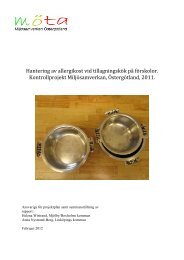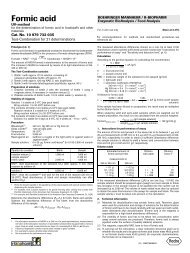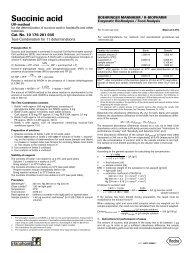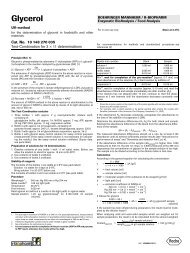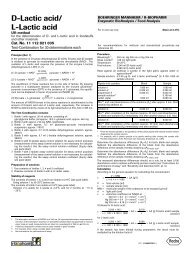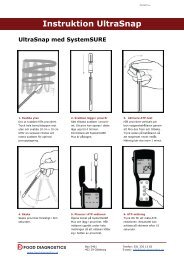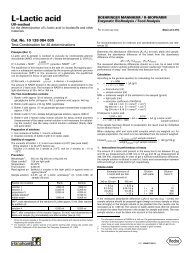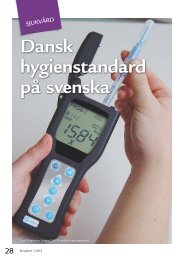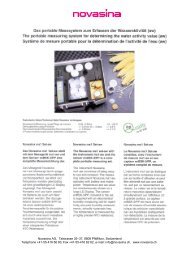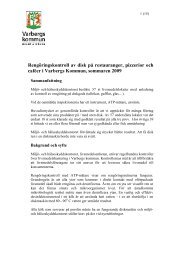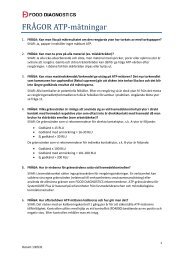Nitrate (NO 3 ) - Food Diagnostics
Nitrate (NO 3 ) - Food Diagnostics
Nitrate (NO 3 ) - Food Diagnostics
You also want an ePaper? Increase the reach of your titles
YUMPU automatically turns print PDFs into web optimized ePapers that Google loves.
<strong>Nitrate</strong> (<strong>NO</strong> 3<br />
<br />
)<br />
UV method<br />
for the determination of nitrate (<strong>NO</strong> 3<br />
) in foodstuffs and<br />
other materials<br />
Cat. No. 10 905 658 035<br />
Test-Combination for 3 × 13 determinations<br />
BOEHRINGER MANNHEIM / R-BIOPHARM<br />
Enzymatic BioAnalysis / <strong>Food</strong> Analysis<br />
For in vitro use only<br />
Store at 2-8°C<br />
For recommendations for methods and standardized procedures see<br />
references (2)<br />
Principle (Ref. 1)<br />
<strong>Nitrate</strong> is reduced by reduced nicotinamide-adenine dinucleotide phosphate<br />
(NADPH) to nitrite in the presence of the enzyme nitrate reductase (NR).<br />
<strong>Nitrate</strong> + NADPH + H + NR<br />
nitrite + NADP + + H 2 O<br />
The amount of NADPH oxidized during the reaction is stoichiometric to the<br />
amount of nitrate. The decrease in NADPH is measured by means of its light<br />
absorbance at 334, 340 or 365 nm.<br />
The Test-Combination contains<br />
1. Bottle 1 with approx. 40 ml solution, consisting of:<br />
imidazole buffer, pH approx. 7.8<br />
2. Bottle 2 with approx. 40 tablets, each tablet contains:<br />
NADPH, approx. 0.5 mg, FAD, approx. 0.01 mg<br />
3. Three bottles 3 with approx. 4 U nitrate reductase each (as lyophilizate)<br />
Preparation of solutions<br />
1. Use contents of bottle 1 undiluted.<br />
2. Dissolve one tablet of bottle 2 with one ml solution of bottle 1 in a<br />
beaker or test-tube dependent on the number of determinations for<br />
each assay (blank and sample). This results in reaction mixture 2*. Use<br />
the enclosed foreceps to take the tablet out from bottle 2.<br />
3. Dissolve contents of one bottle 3 with 0.8 ml redist. water. This results in<br />
solution 3.<br />
Stability of reagents<br />
Solution 1 is stable at 2-8°C (see pack label).<br />
Bring solution 1 to 20-25°C before use.<br />
The contents of bottles 2 and 3 are stable at 2-8°C (see pack label).<br />
Reaction mixture 2 has to be prepared freshly before use*.<br />
Bring reaction mixture 2 to 20-25°C before use.<br />
Solution 3 is stable for 2 weeks at 2-8°C.<br />
Procedure<br />
Wavelength 1 : 340 nm, Hg 365 nm or Hg 334 nm<br />
Glass cuvette 2 : 1.00 cm light path<br />
Temperature: 20-25°C<br />
Final volume: 3.050 ml<br />
Read against air (without a cuvette in the light path) against water or against<br />
blank 3<br />
Sample solution: 0.3-30 g nitrate/assay 4 (in 0.100-2.000 ml sample volume)<br />
Pipette into cuvettes Blank Sample<br />
reaction mixture 2*<br />
1.000 ml<br />
1.000 ml<br />
sample solution**<br />
-<br />
0.100 ml<br />
redist. water<br />
2.000 ml<br />
1.900 ml<br />
Mix***, read absorbances of the solutions (A 1 ) after approx. 3 min and start<br />
reaction by addition of:<br />
solution 3 0.050 ml 0.050 ml<br />
Mix***, read absorbances of the solutions (A 2 ) exactly 40 min after<br />
measuring of A 1 directly one after the other. After exactly another 20 min<br />
read again absorbances of the solutions (A 3 ) one after the other.<br />
* For simplification of the assay performance it is also possible to pipette directly 1.000 ml of<br />
solution 1 into the cuvette and add 1 tablet from bottle 2. After dissolution of the tablet with<br />
the aid of a spatula continue working as described in the procedure. The difference in<br />
volume of ca. 1 % (increase of volume by 1 tablet per 3.050 ml assay volume) has to be taken<br />
into account in the calculation by multiplication of the result with 1.01.<br />
** Rinse the enzyme pipette or the pipette tip of the piston pipette with sample solution before<br />
dispensing the sample solution.<br />
*** For example, with a plastic spatula or by gentle swirling after closing the cuvette, e. g. with<br />
Parafilm (trademark of the American Can Company, Greenwich, Ct., USA)<br />
Determine the absorbance differences (A 1 -A 2 ) and (A 2 -A 3 ) for both, blank<br />
and sample.<br />
Absorbance difference of the blank = (A 1 -A 2 ) blank - 2 × (A 2 -A 3 ) blank<br />
Absorbance difference of the sample = (A 1 -A 2 ) sample - 2 × (A 2 -A 3 ) sample<br />
A nitrate = absorbance difference sample - absorbance difference blank<br />
The measured absorbance difference A nitrate should, as a rule, be at least<br />
0.100 absorbance units to achieve sufficiently precise results (see<br />
"Instructions for performance of assay" and “Sensitivity and detection limit”,<br />
pt.4).<br />
If the absorbance difference of the sample (A sample ) is larger than 1.000<br />
(measured at 340 nm or Hg 334 nm) or 0.500 (measured at Hg 365 nm), the<br />
concentration of nitrate is too high. The sample solution must therefore be<br />
diluted according to the dilution table.<br />
Calculation<br />
According to the general equation for calculating the concentration:<br />
c =<br />
V × MW<br />
× A [g/l]<br />
× d × v × 1000<br />
V = final volume [ml]<br />
v = sample volume [ml]<br />
MW = molecular weight of the substance to be assayed [g/mol]<br />
d = light path [cm]<br />
= extinction coefficient of NADPH at:<br />
340 nm = 6.3 [l × mmol -1 × cm -1 ]<br />
Hg 365 nm = 3.5 [l × mmol -1 × cm -1 ]<br />
Hg 334 nm = 6.18 [l × mmol -1 × cm -1 ]<br />
It follows for nitrate (<strong>NO</strong> 3 ):<br />
3.050 × 62.0<br />
1.891<br />
c =<br />
× A = × A<br />
× 1.00 × 0.100 × 1000 <br />
[g nitrate/l sample solution]<br />
If the sample has been diluted on preparation, the result must be multiplied<br />
by the dilution factor F.<br />
When analyzing solid and semi-solid samples which are weighed out for<br />
sample preparation, the result is to be calculated from the amount weighed:<br />
Content nitrate =<br />
c nitrate [g/l sample solution]<br />
weight sample in g/l sample solution<br />
× 100 [g/100 g]<br />
1. Instructions for performance of assay<br />
The amount of nitrate present in the assay has to be between 0.3 g and<br />
30 g. In order to get a sufficient absorbance difference, the sample solution<br />
is diluted to yield an nitrate concentration between 0.03 and 0.3 g/l.<br />
Dilution table<br />
Estimated amount of nitrate Dilution Dilution<br />
per liter<br />
with water factor F<br />
0.3 g<br />
0.3–3.0 g<br />
3.0–30 g<br />
30 g<br />
-<br />
1 + 9<br />
1 + 99<br />
1 + 999<br />
1<br />
10<br />
100<br />
1000<br />
If the measured absorbance difference (A) is too low (e.g. 0.100), the<br />
sample solution should be prepared again (weigh out more sample or dilute<br />
less strongly) or the sample volume to be pipetted into the cuvette can be<br />
increased up to 2.000 ml. The volume of water added must then be reduced<br />
to obtain the same final volume in the assays for sample and blank. The new<br />
sample volume v must be taken into account in the calculation.<br />
1 The absorption maximum of NADPH is at 340 nm. On spectrophotometers, measurements<br />
are taken at the absorption maximum; if spectralline photometers equipped with a mercury<br />
vapor lamp are used, measurements are taken at a wavelength of 365 nm or 334 nm.<br />
2 If desired, disposable cuvettes may be used instead of glass cuvettes.<br />
3 For example, when using a double-beam spectrophotometer<br />
4 See instructions for performance of the assay<br />
0711.11519891001➅
2. Technical information<br />
2.1 The “diluted Carrez solutions” are sufficient in the determination of<br />
nitrate in fruit and vegetable juices. The “concentrated Carrez solutions”,<br />
however, have to be used in the analysis of meat and meat products for<br />
complete removal of enzymes (from muscle or from starter cultures). It<br />
is necessary in both cases that the pH of the solution is slightly alkaline<br />
(pH 8) after the addition of sodium hydroxide.<br />
2.2 When determining nitrate in trace-level compound analysis,<br />
some points have to be taken into consideration in order to get<br />
satisfying results:<br />
a) Paper or membrane filters have to be free from nitrate.<br />
b) Adsorbents recommended for sample preparation (polyvinylpolypyrrolidone<br />
PVPP, bentonite, ect.) have also to be free from nitrate.<br />
c) The Carrez solutions must be free from nitrate, too.<br />
To check for the absence of nitrate:<br />
a) Wash paper or membrane filter with redist. water and use 2.000 ml of<br />
the washing water for the assay (blank with redist. water).<br />
b) Add water to the absorbents in the volume/quantity ratio given in the<br />
instructions, mix and filter; use 2.000 ml of the filtrate for the assay<br />
(blank with redist. water).<br />
c) Mix redist. water, Carrez-I-solution, Carrez-II-solution and sodium<br />
hydroxide solution in the ratio given in the instructions, mix and filter;<br />
use 2.000 ml of the filtrate for the assay (blank with redist. water).<br />
Also in the case of small amounts of nitrate in the assay, follow the<br />
instructions: read absorbances A 2 exactly 40 min after measuring A 1<br />
and read A 3 after another exactly 20 min.<br />
3. Specificity (Ref. 1.1)<br />
<strong>Nitrate</strong> reductase is to a large extend specific for nitrate ions. The nitrite ions<br />
which are formed during the nitrate reduction are converted only with<br />
neglectable reaction rate. Chlorate ions react with relatively high reaction<br />
rate, but not perchlorate and iodate ions.<br />
In the analysis of commercial potassium nitrate, results of approx. 100 %<br />
have to be expected.<br />
4. Sensitivity and detection limit (Ref. 1.1)<br />
The smallest differentiating absorbance for the procedure is 0.005<br />
absorbance units. This corresponds to a maximum sample volume v = 2.000 ml<br />
and measurement at 340 of a nitrate concentration of 0.1 mg/l sample<br />
solution (if v = 0.100 ml, this corresponds to 2 mg/l sample solution).<br />
The detection limit of 0.15 mg/l is derived from the absorbance difference of<br />
0.010 (as measured at 340 nm) and a maximum sample volume v = 2.000 ml.<br />
5. Linearity<br />
Linearity of the determination exists from 0.3 g nitrate/assay (0.15 mg nitrate/l<br />
sample solution; sample volume v = 2.000 ml) to 30 g nitrate/assay<br />
(0.3 g nitrate/l sample solution; sample volume v = 0.100 ml).<br />
6. Precision<br />
In a double determination using one sample solution, a difference of 0.005 to<br />
0.015 absorbance units may occur. With a sample volume of v = 0.100 ml<br />
and measurement at 340 nm, this corresponds to a nitrate concentration of<br />
approx. 1.5-5 mg/l. (If the sample is diluted during sample preparation, the<br />
result has to be multiplied by the dilution factor F. If the sample is weighed in<br />
for sample preparation, e.g. using 1 g sample/100 ml = 10 g/l, a difference of<br />
0.015-0.05 g/100 g can be expected.)<br />
The following data have been published in the literature:<br />
5.8 g/assay n = 10 CV = 2.7 %<br />
17 g/assay n = 10 CV = 2.8 %<br />
28 g/assay n = 10 CV = 1.3 % (Ref. 1.1)<br />
Radish juice: r = 77.3 mg/l s (r) =±27.3 mg/l<br />
R = 112.2 mg/l s (R) = ± 39.7 mg/l<br />
Carrot juice: r = 12.2 mg/l s (r) = ± 4.3 mg/l<br />
R = 17.7 mg/l s (R) = ± 6.3 mg/l<br />
Beetroot juice: r = 42.8 mg/l s (r) = ± 15.1 mg/l<br />
R = 64.1 mg/l s (R) = ± 22.7 mg/l<br />
Spinach baby food:<br />
x = 64 mg/kg r = 15.5 mg/kg s (r) = ± 5.5 mg/kg<br />
R = 24.5 mg/kg s (R) = ± 8.7 mg/kg (Ref. 2.1)<br />
7. Interference/sources of error<br />
Nitrite ions of the sample inhibit the main reaction at concentrations higher<br />
than 70 g/assay. Manganese ions (5 g/assay) retard the nitrate<br />
conversion. Chloride ions inhibit only at a concentration higher than<br />
4.3 mg/assay. Cyanide ions (1.6 g/assay) and sulfite ions<br />
(100 g/assay) inactivate the nitrate reductase completely.<br />
8. Recognizing interference during the assay procedure<br />
8.1 If the conversion of nitrate has been completed according to the time<br />
given under “Procedure”, it can be concluded in general that no interference<br />
has occurred.<br />
8.2 Operator error or interference of the determination through the<br />
presence of substances contained in the sample can be recognized by<br />
carrying out a double determination using two different sample volumes<br />
(e.g. 0.100 ml and 0.200 ml): the measured differences in absorbance<br />
should be proportional to the sample volumes used.<br />
When analyzing solid samples, it is recommended that different quantities<br />
(e.g. 1 g and 2 g) be weighed into 100 ml volumetric flasks. The<br />
absorbance differences measured and the weights of sample used<br />
should be proportional for identical sample volumes.<br />
8.3 Possible interference caused by substances contained in the sample<br />
can be recognized by using an internal standard as a control: in addition<br />
to the sample, blank and standard determinations, a further determination<br />
should be carried out with sample and assay control solution in the<br />
same assay. The recovery can then be calculated from the absorbance<br />
differences measured.<br />
8.4 Possible losses during the determination can be recognized by carrying<br />
out recovery tests: the sample should be prepared and analyzed with<br />
and without added standard material. The additive should be recovered<br />
quantitatively within the error range of the method.<br />
9. Reagent hazard<br />
The reagents used in the determination of nitrate are not hazardous materials<br />
in the sense of the Hazardous Substances Regulations, the Chemicals Law<br />
or EC Regulation 67/548/EEC and subsequent alteration, supplementation<br />
and adaptation guidelines. However, the general safety measures that apply<br />
to all chemical substances should be adhered to.<br />
After use, the reagents can be disposed of with laboratory waste, but local<br />
regulations must always be observed. Packaging material can be disposed<br />
of in waste destined for recycling.<br />
10. General information on sample preparation<br />
In carrying out the assay:<br />
Use clear, colorless and practically neutral liquid samples directly, or<br />
after dilution according to the dilution table, and of a volume up to 2.000 ml;<br />
Filter turbid solutions;<br />
Degas samples containing carbon dioxide (e.g. by filtration);<br />
Adjust acid samples to pH 8 by adding sodium or potassium hydroxide<br />
solution;<br />
Adjust acid and weakly colored samples to pH 8 by adding sodium or<br />
potassium hydroxide solution and incubate for approx. 15 min;<br />
Treat “strongly colored” samples that are used undiluted or with a higher<br />
sample volume with polyvinylpolypyrrolidone (PVPP) - (e.g. 1 g/100 ml);<br />
Crush or homogenize solid or semi-solid samples, extract with water or<br />
dissolve in water and filter if necessary; resp. remove turbidities or dyestuffs<br />
by Carrez clarification;<br />
Deproteinize samples containing protein with Carrez reagents;<br />
Extract samples containing fat with hot water (extraction temperature<br />
should be above the melting point of the fat involved). Cool to allow the fat<br />
to separate, make up to the mark, place the volumetric flask in an ice bath<br />
for 15 min and filter; alternatively clarify with Carrez-solutions after the<br />
extraction with hot water.<br />
Note: With some sample solutions (e.g. from coffee, colored juice concentrates)<br />
a creep reaction is observed occasionally, even before the<br />
measuring of A 1 . In such cases it is recommended to add polyvinylpolypyrrolidone,<br />
PVPP (1 g/100 ml) or bentonite (1 g/100 ml)<br />
to the sample, to stir for 2 min and subsequently to filter the sample<br />
material.<br />
2
Carrez clarification:<br />
Pipette the liquid sample into a 100 ml volumetric flask which contains<br />
approx. 60 ml redist. water, or weigh sufficient quantity of the sample into a<br />
100 ml volumetric flask and add approx. 60 ml redist. water. Subsequently,<br />
carefully add 5 ml Carrez-I-solution (potassium hexacyanoferrate(II) (ferrocyanide),<br />
85 mM = 3.60 g K 4 [Fe(CN) 6 ] × 3 H 2 O/100 ml) and 5 ml Carrez-IIsolution<br />
(zinc sulfate, 250 mM = 7.20 g ZnSO 4 × 7 H 2 O/100 ml). Adjust to<br />
pH 7.5-8.5 with sodium hydroxide (0.1 M; e.g. 10 ml). Mix after each addition.<br />
Fill the volumetric flask to the mark, mix and filter.<br />
The “concentrated” Carrez solutions have to be used for the preparation of<br />
meat and dairy samples (see pt. 11: application examples).<br />
11. Application examples<br />
Determination of nitrate in water, drinking-water and mineral water<br />
Clear and colorless water samples are used undiluted for the assay or after<br />
dilution according to the dilution table. Turbid water samples are filtered and<br />
used for the assay.<br />
CO 2 -containing samples are filtered, neutralized if necessary, and used for<br />
the assay.<br />
Determination of nitrate in beer<br />
Beer samples are filtered or stirred for 1 min to remove the CO 2 . Add 0.1 g<br />
bentonite to 10 ml CO 2 –free beer sample and stir with a glass rod for approx.<br />
2 min. Filter and use 1.000 ml for the assay.<br />
Determination of nitrate in fruit juice and vegetable juice<br />
Exactly weigh approx. 15 g of homogenized sample into a 100 ml volumetric<br />
flask, add approx. 20 ml redist. water and mix. For clarification, add one after<br />
the other and mix after each addition: 5 ml diluted Carrez-I solution (3.60 g<br />
potassium hexacyanoferrate(II), K 4 [Fe(CN) 6 ] × 3 H 2 O/100 ml) and 5 ml<br />
diluted Carrez-II solution (7.20 g zinc sulfate, ZnSO 4 × 7 H 2 O/100 ml). Adjust<br />
with sodium hydroxide (1 M) to pH 8. Fill up to the mark with redist. water,<br />
mix and filter. Use the clear filtrate (v = 0.100-0.500 ml) for the assay.<br />
Determination of nitrate in wine<br />
Neutralize the sample if necessary. When analyzing red wine add<br />
additionally 1 g polyvinylpolypyrrolidone (PVPP) per 20 ml wine and stir for<br />
approx. 5 min. Filter and use the filtrate for the assay.<br />
Determination of nitrate in fruits and vegetables<br />
Mince the sample and homogenize. Exactly weigh approx. 5 g sample<br />
material into a 100 ml beaker and add approx. 60 ml hot redist. water<br />
(approx. 70°C). Shake and incubate for approx. 15 min at 60–70°C. Strongly<br />
colored products (e.g. beetroot) or samples with a high content of starch<br />
(e.g. potatoes) treat additionally with Carrez reagents (see under fruit juice<br />
and vegetable juice). Allow to cool to 20-25°C and transfer quantitatively<br />
into a 100 ml volumetric flask. Fill up to the mark with redist. water and filter.<br />
Take 0.100-1.000 ml of the filtrate for the assay.<br />
Determination of nitrate in meat and meat products<br />
Mince the sample and homogenize. Exactly weigh approx. 5 g sample<br />
material into a 100 ml beaker and add approx. 50 ml boiling redist. water.<br />
Keep boiling for 15 min and allow to cool to 20–25°C. Add one after the<br />
other 3 ml concentrated Carrez-II solution (15.0 g potassium hexacyanoferrate(II),<br />
K 4 [Fe(CN) 6 ] × 3 H 2 O/100 ml) and 3 ml concentrated Carrez-II solution<br />
(30.0 g zinc sulfate, ZnSO 4 × 7 H 2 O/100 ml) each and mix after each<br />
addition. Adjust to pH 8 with sodium hydroxide (1 M). Transfer the contents<br />
of the beaker quantitatively into a 100 ml volumetric flask, fill up to the mark<br />
with redist. water and mix. For fat separation place the flask for 20 min in a<br />
refrigerator and filter. Discard the first few ml of the filtrate. Use the clear<br />
filtrate for the assay.<br />
If the filtrate is not clear, the sample solution has to be prepared freshly by<br />
using 4 ml (maximum 10 ml) concentrated Carrez-I-solution and<br />
concentrated Carrez-II-solution, each.<br />
Determination of nitrate in dairy products and cheese<br />
Mince the sample and homogenize. Exactly weigh approx. 5 g sample<br />
material into a 100 ml beaker and continue working as described under<br />
“meat and meat products”.<br />
Determination of nitrate in baby food<br />
Mince the sample and homogenize. Exactly weigh approx. 5 g sample<br />
material into a 100 ml beaker and add approx. 50 ml boiling redist. water.<br />
Keep boiling for 15 min and allow to cool to 20–25°C. Add one after the other<br />
diluted Carrez-I solution and diluted Carrez-II solution and mix after each<br />
addition (for preparation see under fruit juice and vegetable juice. Continue<br />
working as described under “meat and meat products”.<br />
12. Further applications<br />
The method may also be used in the examination of pharmaceuticals,<br />
cosmetics, and in environmental analysis and in research when analyzing<br />
biological samples.<br />
References<br />
1.1 Beutler, H.-O., Wurst, B. & Fischer, S. (1986) Eine neue Methode zur enzymatischen<br />
Bestimmung von Nitrat in Lebensmitteln, Deutsche Lebensmittel-Rundschau 82, 283-289<br />
2.1 Amtliche Sammlung von Untersuchungsverfahren nach § 35 LMBG; Untersuchung von<br />
Lebensmitteln: Bestimmung von Nitrat in Gemüsesäften, 26.26-2 (Mai 1988);<br />
Bestimmung von Nitrat in Gemüsebrei für Säuglinge und Kleinkinder, 48.03.05-1 (Mai<br />
1988); Bestimmung des Nitrit- und Nitratgehaltes in Wurstwaren nach enzymatischer<br />
Reduktion, 08.00-14 (Dezember 1990)<br />
2.2 Brautechnische Analysenmethoden, Band II, 2. Auflage, S. 139-141 (1988), Methodensammlung<br />
der Mitteleuropäischen Brautechnischen Analysenkommission (MEBAK),<br />
herausgegeben von F. Drawert im Selbstverlag der MEBAK, Freising<br />
2.3 Deutsche Norm DIN EN 12014-5 (August 1997) Bestimmung des Nitrat und/oder<br />
Nitritgehaltes, Teil 5: Enzymatische Bestimmung des Nitratgehaltes in gemüsehaltiger<br />
Säuglings- und Kleinkindernahrung<br />
2.4 European Standard EN 12014-5 (August 1997) Determination of nitrate and/or nitrite<br />
content, Part 5: Enzymatic determination of nitrate content of vegetable containing food<br />
for babies and infants<br />
3.1 Rohm, H. & Winkler-Macheiner, U. (1987) Eine enzymatische Methode zur Nitratbestimmung<br />
in Anwendung auf Molkenpulver und Käse, ERNÄHRUNG/NUTRITION11, 9-13<br />
3.2 Beutler, H.-O., Wurst, B. & Henniger, G. (1986) Enzymatic Determination of <strong>Nitrate</strong>,<br />
Poster-Präsentation bei Association of Official Analytical Chemists Annual International<br />
Meeting, Scottsdale, AZ, USA<br />
3.3 Kretzschmar, R. & Kretzschmar, T. (1988) Enzymatische Nitratbestimmung in kommunalem<br />
Abwasser, Vom Wasser 70, 119-128<br />
3.4 Brauner-Glaesner, G. & Beutler, H.-O. (1989) Ringversuchsergebnisse zur enzymatischen<br />
Nitratbestimmung, Lebensmittelchem.Gerichtl.Chem. 43, 123-126<br />
3
13. Reference for application in the colorimetric method for the determination of<br />
nitrate and nitrite in sausages/meat products acc. to Arneth (s. Ref. 1.1)*<br />
Principle (Ref. 1.1)<br />
<strong>Nitrate</strong> is reduced by reduced nicotinamide-adenine dinucleotide phosphate<br />
(NADPH) to nitrite in the presence of the enzyme nitrate reductase (NR) (1).<br />
<strong>Nitrate</strong> + NADPH + H +<br />
NR<br />
nitrite + NADP + + H 2 O<br />
Nitrite reacts with sulfanilamide and N-(1-naphthyl)-ethylenediammonium<br />
dichloride with the formation of a red diazo-dyestuff (2).<br />
(2) Nitrite + sulfanilamide + N-(1-naphthyl)-ethylenediamine<br />
diazo-dye<br />
The amount of the diazo-dyestuff formed during the reaction is stoichiometric<br />
to the amount of nitrite. The dyestuff is measured by means of its light<br />
absorbance at 540 nm (Hg 546 nm) in the visible range.<br />
Reagents<br />
I. Dissolve 0.2 g bromothymol blue in 100 ml methylated ethanol (96 %;<br />
w/w).<br />
II. Carrez-I-solution: 150 g K 4 [Fe(CN) 6 ] × 3 H 2 O/l redist. water.<br />
III. Carrez-Il-solution: 230 g Zn(CH 3 COO) 2 × 2 H 2 O/l redist. water.<br />
IV. Use the contents of bottle 1 (imidazol buffer, pH approx. 7.8) of the<br />
Test-Combination <strong>Nitrate</strong> undiluted.<br />
The solution is sufficient for approx. 36 assays.<br />
The solution is stable at 2–8°C (see pack label).<br />
V. Use the tablets from bottle 2 (NADPH, FAD) of the Test-Combination<br />
<strong>Nitrate</strong> unchanged.<br />
The tablets are sufficient for approx. 36 assays.<br />
The tablets are stable at 2–8°C (see pack label).<br />
VI. Use the contents of bottle 3 (nitrate reductase) of the Test-Combination<br />
<strong>Nitrate</strong> unchanged.<br />
Each bottle contains sufficient enzyme for approx. 12 assays.<br />
The contents of bottle 3 are stable at 2–8°C (see pack label).<br />
VII. Buffer/enzyme solution<br />
Dissolve the contents of one bottle 3 of the Test-Combination <strong>Nitrate</strong><br />
with 12 ml imidazole buffer solution (IV) from bottle 1 of the Test-Combination<br />
<strong>Nitrate</strong>, add 50 mg Titriplex III (di-sodium-ethylen-dinitrilotetraacetate-dihydrate)<br />
and mix.<br />
Prepare the solution freshly before use.<br />
VIII.Color reagent<br />
Solution A: Dissolve 8 g sulfanilamide in 500 ml redist. water in a warm<br />
water bath, cool to room temperature and filter, if necessary. While stirring<br />
add 330 ml concentrated hydrochloric acid (free from nitrate and<br />
nitrite), fill up to 1000 ml with redist. water.<br />
The solution is stable at 20°C for several weeks.<br />
Solution B: Dissolve 330 mg N-(1-naphthyl)-ethylene-diammonium<br />
dichloride in 250 ml redist. water.<br />
The solution is stable in a brown bottle at 20°C for 1 week.<br />
Working solution: Mix daily for each assay 1.5 ml solution A and 1.5 ml<br />
solution B.<br />
IX. Sodium nitrite working standard solutions<br />
Dissolve 200 mg sodium nitrite to the nearest 0.1 mg with 500 ml redist.<br />
water in a volumetric flask. Dilute 25 ml of this stock solution in a 500 ml<br />
volumetric flask with redist. water (= 20 mg sodium nitrite/I). Pipette 10,<br />
20, 30 and 40 ml of the diluted stock solution into 200 ml volumetric<br />
flasks. Add 0.2 ml bromothymol blue solution (I), titrate with NaOH (1 M)<br />
until the color changes to blue. Add 2 ml Carrez-I-solution (II) and 2 ml<br />
Carrez-Il-solution (III), mix after each addition, fill the volumetric flasks to<br />
the mark with redist. water, mix and filter. Discard the first parts of the<br />
filtrate.<br />
The working standard solutions (with 1 mg, 2 mg, 3 mg and 4 mg sodium<br />
nitrite/I) have to be prepared daily.<br />
X. <strong>Nitrate</strong> standard solutions<br />
Dissolve 300 mg potassium nitrate (to the nearest 0.1 mg; e.g. Merck<br />
Darmstadt, Cat. no. 5065, suprapur) with 500 ml redist. water in a<br />
volumetric flask. Dilute 25 ml of this stock solution in a 500 ml volumetric<br />
flask with redist. water (= 30 mg potassium nitrate/I). Pipette 10, 20,<br />
30 and 40 ml of the diluted stock solution into 200 ml volumetric flasks.<br />
Add 0.2 ml bromothymol blue solution (I), titrate with NaOH (1 M) until<br />
the color changes to blue. Add 2 ml Carrez-I-solution (II) and 2 ml<br />
Carrez-Il-solution (III), mix after each addition, fill the volumetric flasks<br />
to the mark with redist. water, mix and filter. Discard the first parts of the<br />
filtrate.<br />
The standard solutions (with 1.5 mg, 3 mg, 4.5 mg and 6 mg potassium<br />
nitrate/I) have to be prepared daily.<br />
Procedure<br />
Wavelength 1 : 540 nm (Hg 546 nm)<br />
Glass cuvette 2 : 1.00 cm<br />
Incubation volume: 6.000 ml<br />
Measuring volume:<br />
Read against water<br />
Sample solution:<br />
a) Determination of nitrite<br />
Pipette into<br />
test tubes:<br />
sample solution<br />
working<br />
standards (IX)<br />
redist. water<br />
color reagent (VIII)<br />
approx. 3 ml<br />
b) Determination of nitrate and nitrite<br />
3–12 g potassium nitrate, resp. 2–8 g sodium<br />
nitrite/assay (in 2.000 ml sample solution) 3<br />
Working<br />
standard<br />
Na<strong>NO</strong> 2<br />
1 mg/I<br />
—<br />
2.000 ml<br />
1.000 ml<br />
3.000 ml<br />
Working<br />
standard<br />
Na<strong>NO</strong> 2<br />
2 mg/I<br />
—<br />
2.000 ml<br />
1.000 ml<br />
3.000 ml<br />
Working<br />
standard<br />
Na<strong>NO</strong> 2<br />
3mg/I<br />
—<br />
2.000 ml<br />
1.000 ml<br />
3.000 ml<br />
Working<br />
standard<br />
Na<strong>NO</strong> 2<br />
4 mg/I<br />
Sample<br />
Note: It is not necessary to determine the calibration curve in each series of<br />
analyses. It is sufficient to determine the calibration curves from time<br />
to time, and to run 1 working standard sodium nitrite and 1 standard<br />
potassium nitrate for assay control in each series of analyses.<br />
* Roche tests function of the TC nitrate using the UV method described on<br />
page 1 of the pack insert. When additional reagents from other suppliers<br />
are used in the colorimetric method acc. to Arneth Roche cannot guarantee<br />
for the function.<br />
—<br />
2.000 ml<br />
1.000 ml<br />
3.000 ml<br />
2.000 ml<br />
—<br />
1.000 ml<br />
3.000 ml<br />
Mix, incubate for 30 min at room temperature in the dark. Read the<br />
absorbances of the solutions.<br />
Pipette into<br />
test tubes:<br />
tablet (V)<br />
sample solution<br />
standard<br />
solutions (X)<br />
buffer/enzyme<br />
solution (VII)<br />
Standard<br />
K<strong>NO</strong> 3<br />
1.5 mg/I<br />
1 tablet<br />
—<br />
2.000 ml<br />
1.000 ml<br />
Standard<br />
K<strong>NO</strong> 3<br />
3 mg/I<br />
1 tablet<br />
—<br />
2.000 ml<br />
1.000 ml<br />
Standard<br />
K<strong>NO</strong> 3<br />
4.5 mg/I<br />
1 tablet<br />
—<br />
2.000 ml<br />
1.000 ml<br />
Standard<br />
K<strong>NO</strong> 3<br />
6 mg/I<br />
1 tablet<br />
—<br />
2.000 ml<br />
1.000 ml<br />
Sample<br />
1 tablet<br />
2.000 ml<br />
—<br />
1.000 ml<br />
Incubate at room temperature for 60 min. Add<br />
color reagent (VIII) 3.000 ml 3.000 ml 3.000 ml 3.000 ml 3.000 ml<br />
Mix, incubate for 30 min at room temperature in the dark. Read the<br />
absorbances of the solutions.<br />
1 On spectrophotometers, measurements are taken at 540 nm; if spectralline photometers<br />
equipped with a mercury vapor lamp are used, measurements are taken at 546 nm.<br />
2 If desired disposable cuvettes may be used instead of glass cuvettes.<br />
3 See instructions<br />
4
Calculation<br />
Graphical evaluation<br />
The calculation of results is done with calibration curves prepared with standard<br />
solutions. Plot the absorbance values for the sodium nitrite working<br />
standard solutions and the potassium nitrate standard solutions (ordinate)<br />
against the individual sodium nitrite and potassium nitrate concentrations<br />
(abszissa) in a coordinate system. A linear relationship should result.<br />
One gets for the sample solution A nitrate + nitrite and A nitrite ,<br />
the difference A nitrate + nitrite A nitrite gives A nitrate .<br />
Determine the sodium nitrite and potassium nitrate concentration from the<br />
resp. absorbance values by means of the calibration curves.<br />
When analyzing solid and semi-solid samples which are weighed out for<br />
sample preparation, the result is to be calculated from the amount weighed:<br />
c nitrite × 1000<br />
Content nitrite =<br />
[mg nitrite/kg sample]<br />
weight sample in g/l sample solution<br />
c nitrate × 1000<br />
Content nitrate =<br />
[mg nitrate/kg sample]<br />
weight sample in g/l sample solution<br />
The results are calculated as sodium nitrite and potassium nitrate.<br />
The calculation of nitrate (<strong>NO</strong> 3 ) from K<strong>NO</strong> 3 is done with the factor<br />
62.005/101.11 = 0.613, the calculation of <strong>NO</strong> 2 from Na<strong>NO</strong> 2 with the factor<br />
46.006/68.995 = 0.666<br />
13.1 Instructions for Performance of assay<br />
The amount of nitrite, of nitrate resp., in the assay should range between<br />
2–8 g of nitrite, 3–12 g of nitrate, resp.. The sample solution is diluted<br />
sufficiently to yield a nitrite concentration between 1–4 mg/I, a nitrate<br />
concentration between 1.5–6 mg/I.<br />
13.2 Instructions for sample preparation<br />
Weigh approx. 10 g sample material to the nearest 1 mg into a wide mouth<br />
Erlenmeyer-flask, add 50 ml redist. water and homogenize for 30 to 60 s with<br />
an Ultra-Turrax. Rinse the shaft of the homogenizer with 50 ml hot redist.<br />
water. Add 0.2 ml bromothymol blue solution (I), titrate with NaOH (1 M)<br />
until the color changes (if necessary check with a pH-meter: 8.5; there<br />
may be no clear filtrates after Carrez clarification if the pH is higher), and<br />
incubate for 15 min in a bath with boiling water.<br />
Cool the flask to 20–25°C and transfer the contents quantitatively into a<br />
200 ml volumetric flask. Add one after the other 2 ml Carrez-I-solution (II)<br />
and 2 ml Carrez-Il-solution (III) (4 ml each in the analysis of samples rich in<br />
connective tissue), and mix after each addition. Fill the volumetric flask to<br />
the mark with redist. water, mix and filter with a fluted filter paper. Discard<br />
the first parts of the filtrate. Use the clear filtrate for the assay.<br />
13.3 Precision<br />
The following data for the determination of nitrite have been published in<br />
the literature:<br />
Boiled sausage:<br />
x = 37 mg/kg r = 6 mg <strong>NO</strong> 2 /kg s (r) = ± 2 mg <strong>NO</strong> 2 /kg<br />
R = 8 mg <strong>NO</strong> 2 /kg s (R) = ± 3 mg <strong>NO</strong> 2 /kg<br />
(Ref. 2.1)<br />
References<br />
1.1 Arneth, W. & Herold, B. (1988) Nitrat/Nitrit-Bestimmung m Wurstwaren nach enzymatischer<br />
Reduktion, Fleischwirtschaft 68, 761-764<br />
2.1 Amtliche Sammlung von Untersuchungsverfahren nach §35 LMBG: Untersuchung von<br />
Lebensmitteln: Bestimmung des Nitrit- und Nitrat-Gehaltes in Wurstwaren nach enzymatischer<br />
Reduktion, L 08.00-14 (Dezember 1990)<br />
2.2 Schweizerisches Lebensmittelbuch, Kapitel 22 (Diätetische Lebensmittel und Speziallebensmittel)/12.3<br />
(1990): Provisorische Methode der Subkommission 5<br />
R-BIOPHARM AG<br />
An der neuen Bergstraße 17<br />
D-64297 Darmstadt<br />
Phone + 49 61 51 / 81 02-0<br />
Fax + 49 61 51/ 81 02-20<br />
www.r-biopharm.com



